Fukuchiyama Line
| Fukuchiyama Line | |
|---|---|
| G | |
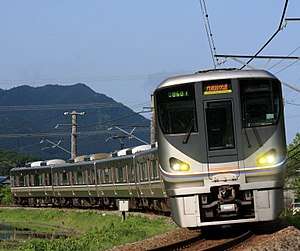 225-6000 series EMU on a Tanbaji Rapid service | |
| Overview | |
| Other name(s) | JR Takarazuka Line |
| Type | Heavy rail |
| System | Urban Network (Amagasaki – Sasayamaguchi) |
| Locale | Hyogo Prefecture and Kyoto Prefecture |
| Termini |
Amagasaki Fukuchiyama |
| Stations | 30 (23 as the JR Takarazuka Line) |
| Operation | |
| Opened | 1891 |
| Owner | JR West |
| Rolling stock |
|
| Technical | |
| Line length | 106.5 km (66.2 mi) |
| Track gauge | 1,067 mm (3 ft 6 in) |
| Electrification | 1,500 V DC, overhead line |
| Operating speed | 120 km/h (75 mph) |
The Fukuchiyama Line (福知山線 Fukuchiyama-sen) is a railway line operated by West Japan Railway Company (JR West) connecting Osaka and Fukuchiyama, Japan. Within JR West's "Urban Network" covering the Osaka–Kobe–Kyoto metropolitan region, the line from Osaka to Sasayamaguchi is also called the JR Takarazuka Line (JR宝塚線). The line traverses the cities of Kawanishi and Takarazuka in the northwestern corner of the Osaka metropolitan area.
Although Amagasaki is the line's official southeastern terminus, all trains continue east to Osaka and beyond on the JR Kōbe Line, or to the Gakkentoshi Line via the JR Tōzai Line.
Basic data
- Operators, distances: 106.5 km / 66.2 mi.
- West Japan Railway Company (Category-1, Services and tracks)
- Track:
- Double-track line:
- From Amagasaki to Sasayamaguchi
- Single-track line:
- From Sasayamaguchi to Fukuchiyama
- Double-track line:
- Railway signalling: Automatic
- Maximum speed:
- From Amagasaki to Shinsanda: 120 km/h
- From Shinsanda to Fukuchiyama: 105 km/h
- CTC centers:
- From Amagasaki to Shinsanda: Ōsaka Operation Control Center
- From Shinsanda to Fukuchiyama: Fukuchiyama Transportation Control Room
- CTC system:
- From Amagasaki to Shinsanda: Safety Urban Network Traffic System (SUNTRAS)
Stations
- S : Trains stop
- s : Limited stop
- | : Trains pass
- Local: Through trains to and from the JR Kyoto Line stop at Tsukamoto Station.
- Rapid: Through trains to and from the JR Tozai Line return at Tsukaguchi Station in the non-rush hour.
| Line name | No. | Station | Distance from Amagasaki Station (km) |
Local | Rapid | Tambaji Rapid | Transfers | Location | ||
|---|---|---|---|---|---|---|---|---|---|---|
| Common | Official | |||||||||
| JR Takarazuka Line | Tōkaidō Main Line | JR-G47 | Osaka | 7.7 | S | S | S |
|
Kita-ku, Osaka | Osaka Prefecture |
| JR-G48 | Tsukamoto | 4.3 | s | | | | | Yodogawa-ku, Osaka | ||||
| JR-G49 | Amagasaki | 0.0 | S | S | S |
|
Amagasaki | Hyōgo Prefecture | ||
| Fukuchiyama Line | ||||||||||
| JR-G50 | Tsukaguchi | 2.5 | S | s | | | |||||
| JR-G51 | Inadera | 3.9 | S | | | | | |||||
| JR-G52 | Itami | 5.8 | S | S | S | Itami | ||||
| JR-G53 | Kita-Itami | 7.9 | S | | | | | |||||
| JR-G54 | Kawanishi-Ikeda | 11.0 | S | S | S |
|
Kawanishi | |||
| JR-G55 | Nakayamadera | 14.5 | S | S | S | Takarazuka | ||||
| JR-G56 | Takarazuka | 17.8 | S | S | S |
| ||||
| JR-G57 | Namaze | 19.7 | S | | | | | Nishinomiya | ||||
| JR-G58 | Nishinomiyanajio | 21.9 | S | S | S | |||||
| JR-G59 | Takedao | 25.1 | S | | | | | Takarazuka | ||||
| JR-G60 | Dōjō | 30.1 | S | | | | | Kita-ku, Kobe | ||||
| JR-G61 | Sanda | 33.7 | S | S | S |
|
Sanda | |||
| JR-G62 | Shin-Sanda | 36.9 | S | S | S | |||||
| JR-G63 | Hirono | 39.7 | S | S | S | |||||
| JR-G64 | Aino | 44.0 | S | S | S | |||||
| JR-G65 | Aimoto | 48.2 | S | S | S | |||||
| JR-G66 | Kusano | 50.2 | S | S | S | Sasayama | ||||
| JR-G67 | Furuichi | 53.5 | S | S | S | |||||
| JR-G68 | Minami-Yashiro | 56.1 | S | S | S | |||||
| JR-G69 | Sasayamaguchi | 58.4 | S | S | S | |||||
| Tamba-Ōyama | 60.7 | S | S | |||||||
| Shimotaki | 68.7 | S | S | Tamba | ||||||
| Tanikawa | 73.0 | S | S | |||||||
| Kaibara | 80.0 | S | S | |||||||
| Iso | 83.2 | S | S | |||||||
| Kuroi | 87.5 | S | S | |||||||
| Ichijima | 94.0 | S | S | |||||||
| Tamba-Takeda | 98.2 | S | S | |||||||
| Fukuchiyama | 106.5 | S | S | Fukuchiyama, Kyoto | ||||||
Rolling stock
Current
- 207 series (Rapid and Local services, through service with Tōkaidō Main Line and Katamachi Line via JR Tōzai Line)
- 223-5500 series (Local and wanman services)
- 223-6000 series (Tanbaji and Rapid services)
- 225-6000 series (Tanbaji and Rapid services)
- 321 series (Rapid and Local services, through service with Tōkaidō Main Line and Katamachi Line via JR Tōzai Line)
- 287 series (Kounotori limited express)
- 289 series (Kounotori limited express, from 31 October 2015)
Former
- 103 series (until November 2005)
- 113 series (until March 2012)
- 115 series (until 2004)
- 117 series (until April 2005)
- 201 series (until March 2007)
- 205 series (until February 2006)
- 221 series (until March 2012)
- 415 series (until 1991)
- 183 series (Kounotori limited express, until 15 March 2013)
- 381 series (Kounotori limited express, until May 2011, from June 2012, until 30 October 2015)
- KiHa 58 series
- KiHa 65 series
- KiHa 47 series
- KiHa 80 series (Matsukaze limited express)
- KiHa 181 series (Matsukaze limited express)
- Kitakinki Tango Railway KTR 001 series (Tango Explorer limited express, until March 2011)
- Kitakinki Tango Railway KTR 8000 series (Tango Explorer limited express, until March 2007)
History
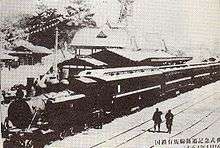
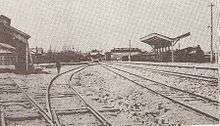
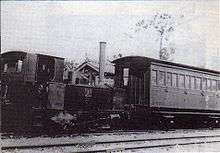
The Japanese Government Railways (JGR) opened the Osaka - Kobe section of what is now the Tokaido Main Line in 1874 as a dual track line.
The Kawabe Horsecar Railway (川辺馬車鉄道 Kawabe Bashatetsudō) opened a 762mm gauge line between Amagasaki and Itami (about 8 km) in 1891. In 1893, the horsecar railway was reorganized as Settsu Railway (摂津鉄道 Settsu Tetsudō), which introduced steam power to the railway and extended the line to Ikeda.
The Settsu Railway was merged by Hankaku Railway (阪鶴鉄道 Hankaku Tetsudō), which had a plan to build a railway between Osaka and Maizuru. The Hankaku Railway converted the line to 1067mm gauge and extended it to Takarazuka in 1897 and to Fukuchiyama in 1899. The company also connected the line to the Kanzaki Station (present-day Amagasaki Station) of the JGR line in 1898 making the line to the original Amagasaki terminal a branch. Hankaku Railway was nationalized on August 1, 1907.
The Amagasaki - Tsukaguchi section was duplicated in 1934, and extended to Takarazuka in 1979/80. The Takarazuka - Shin-Sanda section was duplicated in 1986 in conjunction with the opening of the 2970m Najio tunnel and associated deviation, which shortened the route by 1.8 km. Duplication to Sasayamaguchi was completed in 1996.
The Amagasaki - Tsukaguchi section was electrified in 1956, and extended to Takarazuka in 1981. The remainder of the line was electrified in 1986.
CTC signalling was commissioned between Fukuchiyama and Sasayamaguchi in 1982, extended to Hirono in 1984 and to Amagasaki in 1986.
The branchline between Amagasakikō Station (former Amagasaki terminal of the horsecar railway) and Tsukaguchi Station ceased passenger operation in 1981 and freight operation in 1984.
Former connecting lines
- Sanda station - The 12 km line to Arima operated from 1915 to 1943.
- Sasayama-guchi station - A 5 km line to Sasayama-Cho opened in 1914. During WW2 the Japanese became concerned about the vulnerability of the Sanyo Main Line to naval attacks. A bypass was proposed from Sasayama-guchi to Sonobe on the Sanin Main Line utilising the line to Sasayama-Cho, which was extended 13 km to Fukuzumi in 1944. The remainder of the proposed line was not built due to the cessation of hostilities. The line closed in 1972.
- Fukuchiyama station - The Hokutan Railway Co. operated a 12 km line to Koumori between 1923 and 1971.
Accidents
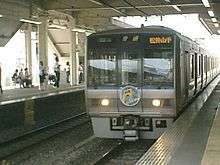
On April 25, 2005, a seven-car 207 series train on a Rapid service derailed and crashed into a building between Tsukaguchi and Amagasaki on its way for Doshisha-mae via the JR Tōzai Line and the Katamachi Line. 107 passengers were killed in the accident. Operations on the affected part of the line remained suspended until trial runs began on June 7, 2005. Passenger service resumed on June 19, 2005.
The train involved was train number 5418M, a limited-stop "Rapid" commuter service from Takarazuka to Dōshisha-mae. It was a seven-car 207 series electric multiple unit (EMU) formation consisting of a 4-car set and a 3-car set coupled together as shown below, with car 1 leading.[1] The train was carrying approximately 580 passengers at the time of the accident.[1]
References
This article incorporates material from the corresponding article in the Japanese Wikipedia
| Wikimedia Commons has media related to Fukuchiyama Line. |
.svg.png)